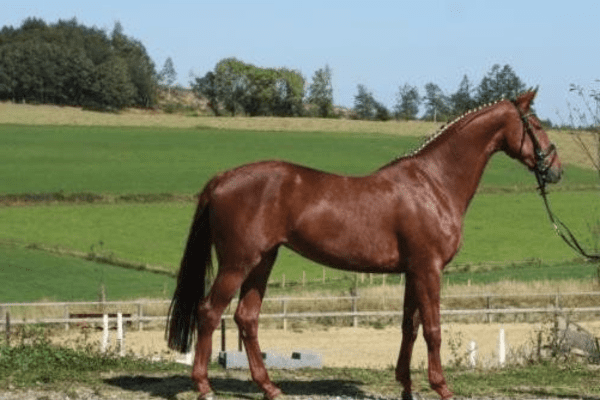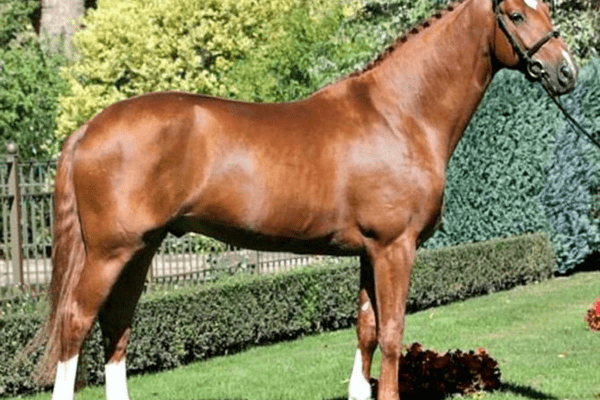The Westphalian horse, often referred to as the Westfalen horse, stands as an emblem of Germany’s rich equestrian tradition. Emerging from Westphalia’s tranquil landscapes, this breed represents strength, grace, and centuries of selective breeding – qualities recognized for their versatility and majestic presence on global equestrian stages around the world.
History:
The Westphalian Horse, long associated with grace, power and versatility, can be traced to Germany’s rich equestrian traditions. Originating in Westphalia region in western Germany, this breed serves as an expression of their nation’s commitment to producing world-class sport horses.
Warendorf State Stud was an institution created in 1826 that sought to elevate horse breeding practices throughout Westphalia and Rheinland provinces. Its existence can be credited to King Frederick William I’s vision in 1713 when he initiated the Prussian Stud Administration for German territories – thus setting in motion an incredible horse breeding renaissance movement that had its beginnings here in Germany.
Key Features: Its initial stallions came from East Prussia, reflecting the popular Trakehner breed which combined traits from both Thoroughbreds and riding horses into versatile horses suitable for courtly rides as well as cavalry duties.
Evolving Demands: With population expansion in the areas between the Rhine and Weser rivers came shifting preferences; adaptable farm horses became necessary due to increasing agricultural activities, prompting an influx of sturdy warmbloods from places such as Oldenburg and East Frisia.
20th Century Trends: At the start of the 20th century, Rhenish Cold Blood horses started outpacing heavier warmblood breeds as the go-to choice for pulling heavy loads such as plowing or artillery plows and artillery cannon. Unfortunately, their role in promoting automotive and agricultural machinery led to decreased demand and caused them to ultimately be phased out altogether.
Wickrath State Stud’s Decline: With heavy horses becoming less popular by 1957, Wickrath State Stud closed. Subsequently, breeds from Hannover provided the basis of contemporary Westphalian horses.
Warendorf’s Federal Riding School has become one of its crowning achievements since 1968. This renowned institution is committed to shaping the future of equestrian sports by training elite riders and instructors for professional competition, acting as central hub of German Equestrian Olympic Committee, upholding tradition through annual stallion performance tests that serve as evidence of its commitment to excellence.

Celebrating Westphalian Horse Tradition to Triumph
Westphalia horses’ journey, steeped in centuries of dedication and precision, is testament to equestrian excellence. 1888 saw Westphalia’s inaugural Studbook established, followed closely by systematic evaluations of both stallions and mares which laid down their unique traits which continue today.
Key Milestones:
Westphalian Evaluations Set the Benchmark: Westphalian evaluations were an exemplar, mirroring other well-known warmblood breeds’ standards for evaluations. Only top fillies were recognized and their breeders awarded rewards, helping ensure Westphalia continued as a hub of superior breeding stock.
Elitism in Breeding: Only those young male horses which best met with their breeders’ vision of breeding stallions were chosen for this esteemed position.
Performance Tests: First introduced in 1905, these tests required stallions to excel not just in appearance but also their performance under saddle or when leading a plough.
World War II brought devastating destruction, destroying pedigree records carefully kept. But resilience prevailed: in 1946, breeders reconvened with an inspired goal: creating the ultimate riding horse.
Modern Accomplishments: Went enacted in 1982, this test further refined the selection process by emphasizing both form and function in its selection process.
Olympic Glorification: Ahlerich, a Westphalian horse, represented his community well at the 1984 Los Angeles Olympic Games when he earned gold medal in dressage competition. This accomplishment highlighted their hard work and commitment.
While some equestrian registries have increasingly turned towards focused breeding programs, Westphallian verband stands out by taking an all-inclusive approach and producing horses with superior movement and jumping capabilities.
Westphalian Philosophy:
Their breeding philosophy caters mainly towards amateur riders, emphasizing the production of versatile horses known for their amicability and adaptability – qualities which make the Westphalian horse such a sought-after choice among many equestrian enthusiasts.

Characteristics :
Breeding Standards: Westphalians uphold high breeding standards similar to other famous German warmbloods.
Genetic Connections: They share important genetic traits with their neighboring breeds, the Rhinelander and Hanoverian.
Ideal Attributes: Westphalians are known for their elegant, bold and fluid movements that make them suitable for various riding styles.
Temperament: Their excellent temperament, integrity, and rideability makes them adaptable and reliable companions.
Physical Description: Although they tend to have more robust builds than Thoroughbreds, these dogs tend to be less coarse than “cold blooded” breeds.
Stature: These dogs typically stand 15.2- 17.2 hands at their withers (approximately 62 to 70 inches or 157-178 cm).
Weight: Their range lies from 1000-1300 lbs.
Color Palette: While the Westphalian Registry (verband) does not restrict or discriminate between coat colors, shades such as black, bay, chestnut, and grey typically predominate in terms of coat colors.
Unique Identification: Westphalians can easily be recognized at foal presentation ceremonies as they receive a distinctive brand with a crown shield featuring the letter W on their left hip, making them easily recognizable.
Westphalian Horse in Sports: An Equestrian Marvel
Introduction
The Westphalian Horse hailing from Westphalia region in northwest Germany has made an immense mark in various equestrian sports worldwide. Esteemed for their strength, intelligence, and versatility; Westphalians are widely utilized and celebrated across a range of arenas worldwide for dressage, jumping and eventing competition. Their legacy remains immortal.
Elegance and Power in Dressage:
Westphalian horses have made their mark in dressage by displaying an exceptional ability to learn complex movements gracefully and precisely, as well as excel at being trained.
Their natural propensity for elegant motion combined with exceptional trainability has allowed riders to reach unparalleled levels of performance – particularly competitive international dressage competition.
Their mental agility and willingness to work alongside human partners creates a dance-like quality in dressage that perfectly embodies strength and suppleness in equal measures.

Precision and Bravery in Jumping:
Showjumping is where Westphalian horses truly shine, showing not only physical prowess but also an indomitable spirit.
Renowned for their powerful hindquarters and agile movement, Westphalians effortlessly negotiate tight turns while clearing towering obstacles with precision and assurance.
In numerous international competitions they have proven their abilities both with regard to jumping ability as well as consistency of performance.
Versatility in Eventing:
Eventing, the triathlon of equestrian sports, requires versatile horses capable of performing in dressage, cross-country, and showjumping disciplines.
Westphalian horses with their multifaceted capabilities naturally gravitate toward this discipline – they exhibit adventurous spirit in cross-country phases, exquisite dressage execution, and careful agility when jumping; becoming indispensable athletes necessary for eventing competitions.
Their sturdy constitution and adaptable nature have seen Westphalian horses win numerous eventing championships over time.
Contribution to Other Equestrian Sports:
In addition to traditional dressage, jumping, and eventing disciplines, Westphalian horses have also proven their versatility in driving and endurance riding competitions. Their sturdy build and willing temperament make them suitable competitors in endurance riding events while their balanced movement and mental stability help ensure precise maneuvers necessary for driving competitions.
Breeding and Training Excellence:
Westphalian horses’ success in equestrian sports is no coincidence but rather due to the strategic breeding and training practices implemented by Westphalia professionals.
Breeders have preserved and enhanced intrinsic qualities within each generation so as to foster superior physical and mental attributes conducive to high performance in various equestrian disciplines.
Iconic Westphalian Horses in Sports:
Many iconic Westphalian horses have cemented their place in history by producing remarkable performances on the international equestrian stage.
Ahlerich, under Dr. Reiner Klimke’s saddle, and Damon Hill under Helen Langehanenberg both proved themselves as standout performers on this global platform, winning Olympic medals and World Championship titles along the way – highlighting that Westphalians can compete successfully at even the highest levels of equestrian sports competition.

